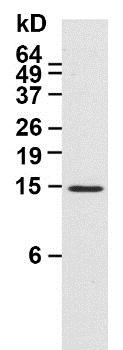Core component of nucleosome which plays a central role in DNA double strand break (DSB) repair. Nucleosomes wrap and compact DNA into chromatin, limiting DNA accessibility to the cellular machineries which require DNA as a template. Histones thereby play a central role in transcription regulation, DNA repair, DNA replication and chromosomal stability. DNA accessibility is regulated via a complex set of post-translational modifications of histones, also called histone code, and nucleosome remodeling. Post-translational modification for Saccharomyces cerevisiae: Phosphorylated to form H2AS128ph (gamma-H2A) in response to DNA double-strand breaks (DSBs) generated by exogenous genotoxic agents and by stalled replication forks. Phosphorylation is dependent on the DNA damage checkpoint kinases MEC1/ATR and TEL1/ATM, spreads on either side of a detected DSB site and may mark the surrounding chromatin for recruitment of proteins required for DNA damage signaling and repair. Gamma-H2A interacts with ARP4, a shared component of the NuA4 histone acetyltransferase complex and the INO80 and SWR1 chromatin remodeling complexes, and serves to recruit first NuA4, mediating histone H4 acetylation, and subsequently the INO80/SWR1 complexes, facilitating DNA resection, to DSB sites. Gamma-H2A is required for sequestering cohesin around the break site, which is important for efficient post-replicative double-strand break repair by homologous recombination, holding the damaged chromatid close to its undamaged sister template. Dephosphorylation is necessary for efficient recovery from the DNA damage checkpoint. N-acetylated by NAT4. Acetylated by ESA1, a component of the NuA4 histone acetyltransferase (HAT) complex, to form H2AK4ac and H2AK7ac. Post-translational modification for Schizosaccharomyces pombe: Phosphorylated to form H2AS128ph (gamma-H2A) in response to DNA double-strand breaks (DSBs) generated by exogenous genotoxic agents and by stalled replication forks. Phosphorylation is dependent on the DNA damage checkpoint kinases rad3/ATR and tel1/ATM, spreads on either side of a detected DSB site and may mark the surrounding chromatin for recruitment of proteins required for DNA damage signaling and repair. Gamma-H2A is required for recruiting crb2, a modulator of DNA damage checkpoint signaling, to DSB sites. Gamma-H2A is removed from the DNA prior to the strand invasion-primer extension step of the repair process and subsequently dephosphorylated. Dephosphorylation is necessary for efficient recovery from the DNA damage checkpoint. Acetylated by esa1 to form H2AK4ac and H2AK7ac.
UniProt ID:
P0C0S8

